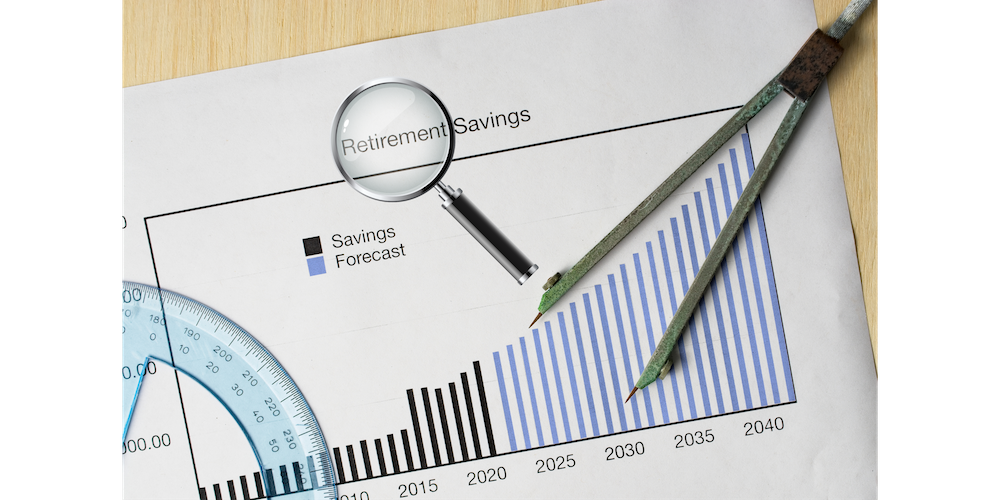As retirement approaches, many realize they haven’t saved as much as they intended. There could be a wide variety of reasons for this. Life sends a lot of curveballs our way–unexpected medical expenses, unexpected job changes, etc. The curve balls that cost us money are far more frequent than the ones that make us money.
This being so, as many people begin approaching retirement age they realize they haven’t been able to save as much as they’d hoped.
For those aged 50 and older, there’s a valuable tool designed to help with saving for retirement: catch-up contributions. This article will explore what catch-up contributions are, why they are important, and how you can take advantage of them to secure a more comfortable retirement.
You’ll also learn why it’s important to understand the impact of trading extra retirement savings now for potentially higher taxation in the future. For those we work with, we create a tax forecast for their retirement. At the end of this article, you’ll learn how you can get your own retirement tax forecast.
First though, how much should you have saved for retirement according to the average retirement age for where you live?
Average Retirement Age By State
While we provide financial planning services for folks across the nation, we’ll use two states we regularly serve–New Hampshire and Arizona–as an example.
According to a study performed by Yahoo Finance, the average age of retirement in New Hampshire is 65. The average age of retirement in Arizona is 63. How much should you have saved for retirement by that age in New Hampshire and Arizona? According to that same study, $930,159 and $991,560, respectively.
How do these numbers stack up against the average American approaching retirement age? According to the Federal Reserve, on average, Americans aged 55-64 have a little over $537,000 in retirement savings–well below the recommended amount above for either state.
Of course, the amount needed when saving for retirement varies as much as the individuals doing so. Every individual or family has different income needs and different retirement goals, so without an individual retirement plan, recommendations can only be given in broad strokes.
Still, based on our interactions with a large sample size of those who are looking ahead to retirement, many feel somewhere in the range of “uncertain” to “not comfortable at all” as it relates to their retirement income plan.
The IRS knows this to be the case and so have created a provision for those approaching retirement age.
Understanding Catch-Up Contributions
Catch-up contributions are additional contributions that individuals aged 50 and older can make to their retirement accounts. Who can especially benefit from this provision? Older workers who may have started saving late, those who’ve experienced financial setbacks, anyone who simply wants to maximize their retirement savings as they near retirement age.
Types of Retirement Accounts Eligible for Catch-Up Contributions
Several types of retirement accounts allow for catch-up contributions, including:
- 401(k) Plans: The most common type of retirement account. 401(k)s are employer-sponsored retirement savings plans where employees can defer part of their salary and where their employer may offer a percentage match.
- 403(b) Plans: Similar to 401(k) plans, but typically available to employees of public schools and certain tax-exempt organizations.
- 457(b) Plans: Again, similar to 401(k)s, but these are primarily offered to state and local government employees and certain non-profit organizations.
- SIMPLE Plans: A type of employer-sponsored plan that has smaller allowable contribution limits than the above plans. Used primarily for small employers
- Traditional and Roth IRAs: These are tax-advantaged individual retirement accounts that offer tax advantages for retirement savings.
Contribution Limits for Catch-Up Contributions
The IRS sets annual limits for retirement contributions, and these limits are adjusted periodically for inflation. For the year 2024, the standard contribution limits and catch-up contribution limits are as follows:
- 401(k), 403(b), and 457(b) Plans:
- Standard limit: $23,000
- Catch-up limit: Additional $7,500, for a total of $35,000
- SIMPLE Plans:
- Standard limit: $16,000
- Catch-up limit: Additional $3,500, for a total of $19,500
- Traditional and Roth IRAs:
- Standard limit: $7,000
- Catch-up limit: Additional $1,000, for a total of $8,000
Why Catch-Up Contributions Matter
Catch-up contributions can play a crucial role in retirement planning for several reasons:
- Maximize Saving for Retirement: They allow individuals to increase their retirement savings significantly, helping to close the gap between what has been saved and what is needed for a comfortable retirement.
- Tax Benefits: Contributions to the above retirement accounts are typically tax-deductible, reducing taxable income for the year they are made. Roth IRA contributions are made with after-tax dollars, but qualified withdrawals in retirement are tax-free.
- Take Advantage of Compounding Interest: The additional funds benefit from the power of compounding growth, potentially increasing the retirement nest egg over time.
- Flexibility: In general, individuals earn more money later in life. This being so, catch-up contributions provide a flexible way to leverage this potential abundance later in life to offset what may have been an earlier deficiency.
How to Make Catch-Up Contributions
Making catch-up contributions involves a few steps:
- Review Your Retirement Accounts: Determine which of your retirement accounts are eligible for catch-up contributions and the specific rules and limits for that relate to your accounts.
- Adjust Your Contributions: How do you actually go about increasing your contribution amounts? If you have an employer sponsored plan, you’d need to do this through your payroll system. For individual accounts, you can increase your contribution directly through the custodian you use.
- Monitor Your Contributions: Know how much you’re contributing each year (especially if you’re doing so monthly or paycheck-by-paycheck. You’ll want to make sure not to exceed the annual limits set by the IRS.
- Consult a Financial Advisor: Do you need to make additional contributions into your retirement savings in order to meet your retirement goals? If so, how much exactly? How will this affect your taxation now and in retirement? Are there other, less common retirement savings vehicles that may be available to you? A consultation with a financial planner could
We offer these consultations to the public free of charge and no obligation. This gives the folks we meet with in our community a better idea of where they stand looking ahead to retirement and the retirement strategies that they may be able to take advantage of.
Case Study: Catch-Up Contributions in Action
To illustrate the value of catch-up contributions, let’s consider a hypothetical example:
John, Age 50: John has a 401(k) plan through his employer and has been contributing the maximum standard limit each year. As he turns 50, he decides to take advantage of catch-up contributions.
- Current 401(k) Balance: $300,000
- Annual Contribution Before Catch-Up: $22,500
- Annual Catch-Up Contribution: $7,500
- Total Annual Contribution After Catch-Up: $30,000
Assuming an average annual return of 6%, here’s how John’s 401(k) balance could grow over the next 15 years until he retires at age 65:
- Without Catch-Up Contributions: Approximately $815,000
- With Catch-Up Contributions: Approximately $990,000
By making catch-up contributions, John could potentially increase his retirement savings by $175,000, demonstrating the significant impact these additional contributions can have. And of course, even after retirement, John’s retirement account balance will continue to be able to accrue interest, making that extra $175,000 all the more valuable.
Frequently Asked Questions
- Who is eligible for catch-up contributions?
- Individuals aged 50 or older are eligible to make catch-up contributions to their eligible retirement accounts.
- Can I make catch-up contributions if I am still working part-time?
- Yes, as long as you are 50 or older and have earned income, you can make catch-up contributions to your retirement accounts.
- Are catch-up contributions tax-deductible?
- Save for Roth IRAs, all money you contribute to the types of retirement accounts discussed in this article are tax deductible.
- Do catch-up contributions affect my required minimum distributions (RMDs)?
- Catch-up contributions increase the balance of your retirement accounts, which may result in higher RMDs later in life. However, the benefit of having a larger retirement savings balance generally outweighs the impact of increased RMDs.
Final Thoughts
Whether it’s a necessity and you need to, well, catch up, or it’s simply an added comfort, catch-up contributions can have a major effect in a small amount of time as it relates to saving for retirement.
Still, like any retirement strategy, it’s best to consult a financial advisor specializing in retirement planning before implementation. Even for something relatively simple such as catch-up contributions? Yes. One reason being is that catch-up contributions, while simple, do have an impact on an aspect of your retirement that is more complex–taxation. As mentioned above, the higher the balance of your retirement accounts, the higher the RMDs. The higher the RMDs, the more your hard-saved money will be subject to taxation.
A financial planner specializing in tax minimization will be able to help you get control now over your taxation in the future. For example, be able to map out your retirement taxation to see if you need to strike a better balance between qualified and non-qualified accounts.
If you’d like to find out if you should be taking advantage of this provision, would like to see a forecast of your taxes in retirement, or simple a second opinion from a fiduciary financial advisor on how effective your retirement plan is click the button below.


